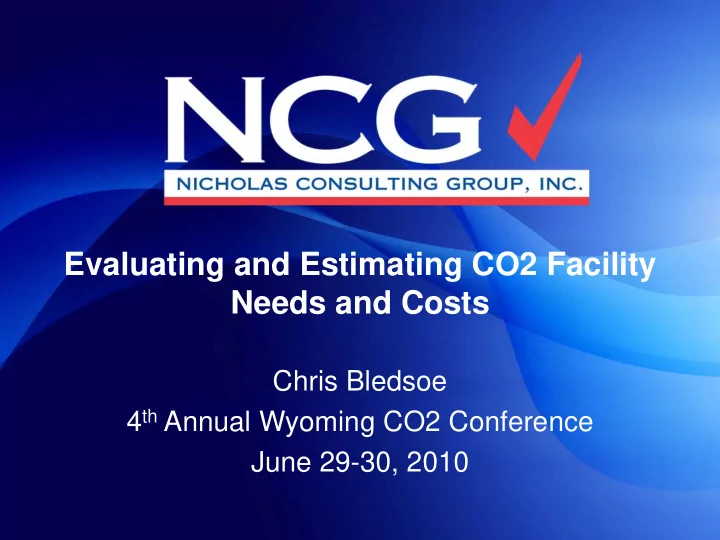

Evaluating and Estimating CO2 Facility Needs and Costs Chris Bledsoe 4 th Annual Wyoming CO2 Conference June 29-30, 2010
Overview • Understand the process for evaluating CO2 facility needs • Overview of FEED study topics • Discuss facility issues evaluated during FEED study • Basics of cost estimating for CO2 projects
FEED Study Goals • Develop conceptual design of facilities • Evaluate alternatives and options • Provide cost estimates for analysis of project economics • Develop schedule for project design, construction, and implementation • Identify risks which could impact project cost and/or schedule
CO2 Project FEED Study Topics CO 2 Supply Regulatory Facilities Water Disposal Flood Management
CO2 Supply CO 2 Supply • Where are w e getting the CO 2 ? Regulatory • Purchased vs. Recycle • CO 2 Pipeline Specs Facilities Water Disposal Flood Management
Regulatory CO 2 Supply • Regulation for H 2 S Operations • Sour Gas Pipeline Construction Regulatory • Injection Well Permitting • Emissions Limits Facilities Water Disposal Flood Management
Facilities CO 2 Supply Regulatory • Gas Processing / Recycle Facility • Surface Production Facilities Facilities • Surface Injection Facilities • Safety Systems Water Disposal Flood Management
Water Disposal CO 2 Supply Regulatory • Waterflood makeup w ater • New or existing w ater disposal Facilities w ells • Commercial w ater disposal Water Disposal systems Flood Management
Flood Management CO 2 Supply Regulatory • Injection Well Operation • Production Well Operation Facilities • Data Collection / Automation • Staffing Levels Water Disposal Flood Management
CO 2 Supply • Sources – Geologic (Sheep Mountain, Bravo Dome) – Anthropogenic (Natural Gas Plants, Ethanol Plants) • Delivery Method – Pipeline – Trucking • Delivery Conditions – Pressure – Temperature – Composition – Water Content
Gas Processing • What to do with the recycle gas stream – Hydrocarbon recovery – Full-stream reinjection • Dehydration • Compression – Optimal operating pressures – Horsepower requirements – Gas engine vs. electric motor drive – Efficiency of pumping vs. compression
Typical Recycle Stream Produced Inlet Dehydration Re-Injection Field Gas Stream Compression (if necessary) Compression Injection Emergency Flare
Production Facilities Operating pressure � Flowline sizing and materials � Separator sizing � Adequate test facilities? � Automation requirements � Vent / relief systems � Water and oil separation � Storage capacity – adequate tankage? � Vapor recovery �
Injection System � Operating pressure � Water and CO2 distribution system layout � Injection flowline sizing and materials � Hydraulic modeling of injection system � WAG injection skid design / location
Water Handling � Where to put excess produced water? – Utilize in existing waterflood – Use for “fill-up” in future CO2 project phases – Water disposal wells – Surface discharge permits � Make up water
Auxiliary Systems � Electric power availability – Coordinate with electric power provider – Power system analysis � Fuel gas needs and availability
Cost Estimating • Utilize conceptual design from FEED study • Focus on capturing MAJOR costs • Understand the level of accuracy • Estimating methods – Vendor quotes – Historical information – Rules of thumb (i.e. $60,000 / inch-mile) • Acknowledge regional factors
FEED Study Deliverables • Technical Report – Summary of study – Design description and justification – Comparison of design alternatives • Capital and Operating Cost Estimates • Project Schedule • Risk Analysis • Process Flow Diagram(s) • Field Layout / Routing Plans
Needs from Client • Results of reservoir modeling – Forecast production/injection rates and pressures • Maps – Field map with well and facility locations – Pipeline maps (CO2 delivery, sales pipelines, etc.) – Power distribution system map • Fluid properties • Information on existing facilities – Equipment lists, drawings, etc.
Questions?
Recommend
More recommend